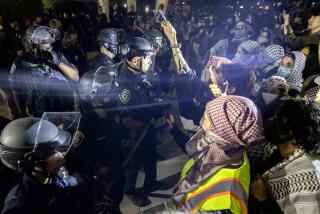Prop. 187 Youth Protest Turns Tense : Activism: Multi-agency police force exerts tight control of students’ movement. The mood is cooperative until the time comes to leave Plaza Park.
- Share via
The march was about to begin. And the school district had finally given up hopes of stopping it.
Now it was time for school officials and police to worry about keeping things under control.
A few minutes after 9 a.m. Friday, the words crackled over the walkie-talkie of a Hueneme High School campus supervisor.
“They’re going to march along J Street,” an unnamed school official said.
So when the school bell rang minutes later and teen-agers poured out of their classes, the supervisor, who gave only the name Esther, knew what to expect. She stood by the wide-open school gate and waited.
Outside the school, at least half a dozen police in squad cars and on motorcycles waited, too.
But for a few minutes, students seemed unsure about whether to leave.
All week teachers and school officials had been visiting classrooms and broadcasting messages over the intercom warning that any student who joined the demonstration would face punishment.
Now the school gate was open. What was going on?
One boy walked shyly up to Esther. “They aren’t going to do nothing to us?” he asked.
“No,” she said gently. “That’s why the gates are open. You can go out this way.”
And within minutes they were gone. More than 300 students marched out, hoisting signs exhorting “No on 187” and unfurling flags of Mexico and the United States.
As the students walked down J Street toward the downtown park to meet hundreds of youths from other schools, Oxnard police squad cars and motorcycles rode ahead, alongside and behind them, keeping the students safe from traffic.
“You’re moving the right way,” one officer said over a loudspeaker to the students as they crossed an intersection.
Another officer pleaded: “You guys, stay on the sidewalk.”
All together, 93 officers from the California Highway Patrol, the Oxnard police and Ventura County sheriff’s departments joined the effort that was coordinated by Oxnard Police Chief Harold Hurtt.
“The message we sent was to keep the marchers on the sidewalks, and just guide them to Plaza Park,” Hurtt said later. “Our purpose was to get them there and get them there safely.”
As each group of marchers arrived at the park, they were greeted with cheers by the students already there. Eventually, the numbers swelled to about 1,200 students and several hundred other protesters.
While some students hung out along the edges of the park, most moved toward the middle to join a student-led rally blasting Proposition 187. Several school employees videotaped the students, planning to use the tapes to identify those who had left the schools.
Meanwhile, the police circled the park.
A dozen sheriff’s deputies on horseback formed a line on one side of the park, and police in riot gear, on motorcycles and inside squad cars were on the other streets. When some stragglers from the protest tried to leave, officers kept them there.
“Our plan once we got them to Plaza Park was to get them contained, and either get them onto buses or let them go back the way they came,” Hurtt said. “We put a horseshoe (of officers) on the north, south and east ends of the park so they could only go west.”
*
But the police either failed to communicate this plan to student organizers or the leaders ignored it.
When the crowd began to get restless after the 90-minute rally, Oxnard College student Lorenzo Zwaal warned the students not to board the fleet of yellow buses parked nearby. School officials would take pictures of students boarding the buses to identify them for future punishment, he said.
Zwaal and other organizers tried to lead the crowd to march down Oxnard Boulevard. But they were met by the line of mounted deputies.
Students turned around and headed the other way. But instead of going straight west down 5th Street as police had hoped, a stream of youths cut through the middle of a line of riot-helmeted officers, climbed over cars and walked through a parking lot to C Street.
Officers quickly changed their game plan, as deputies on horseback and police in squad cars raced to catch up to the marchers.
The mood between the students and officers suddenly changed.
Instead of calling out friendly reminders for students to march on the sidewalk, the officers barked directions.
When mounted deputies broke up a scuffle among a few boys, the officers grabbed two of the boys by their shirts and held them, dragging them a few feet as the horses moved back from the crowd.
*
This sparked an outcry from the students, who angrily threw paper flyers--the only weapons they had--at the officers.
The tension broke as the crowd slowly dispersed.
School officials said most of the protesters returned to their schools by the end of the day. And when the students walked off the streets and back to their campuses, the role of the police ended and the district took control again.
Through videotapes, photographs and lists of the names of students who returned to school, school officials hope to identify and punish all of the youths who walked out.
Contributing to this report were Times staff writers Fred Alvarez and Christina Lima and correspondents Ira E. Stoll and Julie Fields.
* MAIN STORY: A1
More to Read
Sign up for Essential California
The most important California stories and recommendations in your inbox every morning.
You may occasionally receive promotional content from the Los Angeles Times.










